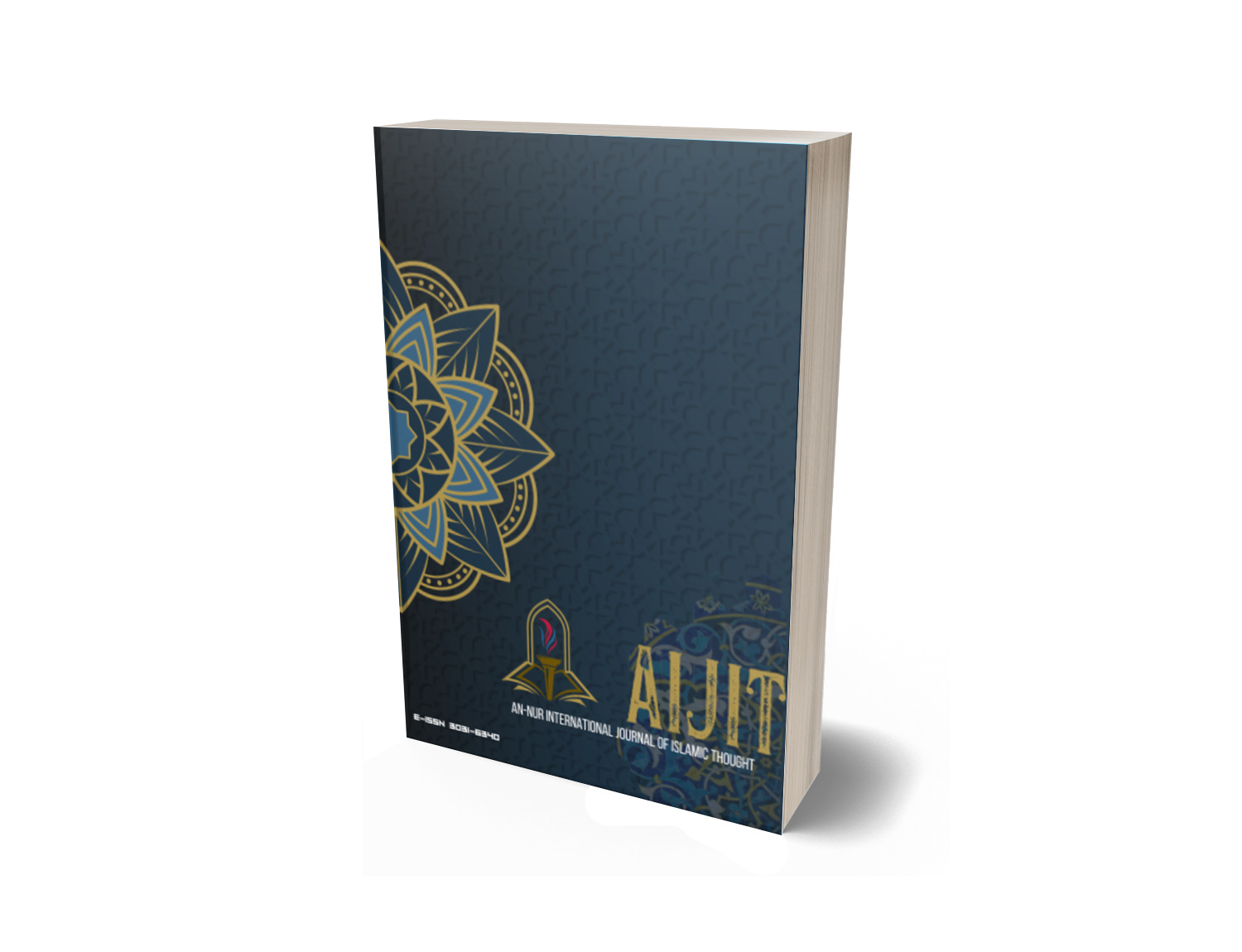Theological Divergence and Political Convergence in Salafiyyah and the Muslim Brotherhood
Keywords:
Salafiyyah, Muslim Brotherhood, Tawḥīd, Revivalism, Political IslamAbstract
This study explores the theological and political dimensions of two major Islamic revivalist movements: Salafiyyah and the Muslim Brotherhood. It begins by situating both within the broader context of colonialism, the collapse of the Ottoman Caliphate, and the subsequent crisis of modernity in the Muslim world. Methodologically grounded in library-based qualitative research and comparative textual analysis, the study traces the evolution of Salafiyyah from Hadith-centered traditionalism to its revivalist expression in figures such as Ahmad ibn Hanbal, Ibn Taymiyyah, and Muhammad ibn 'Abd al-Wahhab. Parallelly, it examines the emergence of the Muslim Brotherhood under Hasan al-Banna, focusing on its holistic Islamic vision that integrates theology with education, political activism, and social welfare. Results indicate that while both movements uphold core Sunni beliefs—particularly Tawḥīd and the rejection of Bidʿah—they differ sharply in strategic orientation. Salafiyyah emphasizes theological rigidity and purification, often leading to polemical exclusivism, whereas the Brotherhood employs theology as a platform for unity and pragmatic reform. These contrasting approaches reflect deeper tensions in how modern Muslims negotiate tradition, authority, and modernity. The study concludes by highlighting the contribution of both movements to Islamic revivalism and their enduring impact on contemporary Muslim political and spiritual thought.
Downloads
References
Agustono, I. (2023). Islamic Puritanism Movement of Muhammad Ibn ‘Abd Al-Wahhab. Lisan Al-Hal Jurnal Pengembangan Pemikiran Dan Kebudayaan, 17(2), 191–203. https://doi.org/10.35316/lisanalhal.v17i2.191-203
al-Bannā, Ḥasan. (1998). Majmūʿat Rasāʾil al-Imām Ḥasan al-Bannā. Dār al-Daʿwah.
al-Bannā, Ḥasan. (2011). Mudhakirāt al-daʻwah wa-al-dāʻīyah (al-Ṭabʻah). Markaz al-Iʻlām al-ʻArabī.
al-Ḥāshidī, F. (2002). Risālatun Ukhawiyyah. Dār al-Āthār.
Al-Janabi, M. M. (2020). The theological and political idea of modern Salafism by Anwar al-Jundi. RUDN Journal of Philosophy, 24(1), 55–63. https://doi.org/10.22363/2313-2302-2020-24-1-55-63
al‐Anani, K. (2019). The Inclusion-Moderation Thesis: Muslim Brotherhood in Egypt. https://doi.org/10.1093/acrefore/9780190228637.013.1332
al‐Anani, K. (2020). Devout Neoliberalism?! Explaining Egypt’s Muslim Brotherhood’s Socio-Economic Perspective and Policies. Politics and Religion, 13(4), 748–767. https://doi.org/10.1017/s1755048320000085
Ali, J. (2022). Modernity, Its Crisis and Islamic Revivalism. Religions. https://doi.org/10.3390/rel14010015
Aminrazavi, M. (2021). Islamic Theology ( Kalām ). 1–7. https://doi.org/10.1002/9781119009924.eopr0186
Arikewuyo, A. (2019). A Comparative Analysis of the Theological Polemics of Muslim Brotherhood and Salafiyyah. International Journal of Islamic Thought. https://doi.org/10.24035/IJIT.15.2019.002
Bakrū, A. (2012). Muḥāḍarāt fī al-Salafiyyah. Dār Ibn al-Jawzī.
Blankinship, L. A., Gillaspie, S., Obaideen, K., & Aboul-Enein, B. H. (2024). ‘… And We have made from water every living thing’: water conservation and the Holy Qur’an. Environmental Conservation, 51(2), 79–84. https://doi.org/10.1017/S037689292300036X
Gani, J. K. (2023). Anti-colonial connectivity between Islamicate movements in the Middle East and South Asia: the Muslim Brotherhood and Jamati Islam. Postcolonial Studies, 26(1), 55–76. https://doi.org/10.1080/13688790.2023.2127660
Hasan, M., Al-Hasani, S., & Maola, M. (2024). IBN HAZM FRAMEWORK OF COMPARATIVE RELIGION BASED ON HIS BOOK AL-FASL FI AL-MILAL WA AL-AHWA WA AL-NIHAL. Quantum Journal of Social Sciences and Humanities. https://doi.org/10.55197/qjssh.v5i1.353
Houston, S. (2018). “Monks by Night and Knights by Day”: Ḥasan Al‐Bannāʾ,Tarbīya, and the Embodied Ethics of the Early Muslim Brotherhood. Religion Compass, 12(7). https://doi.org/10.1111/rec3.12266
Ibn-Taymiyyah, T. al-D. A. (2006). Majmūʿat al-Fatāwá. Dār al-Ḥadīth.
Ibn ʿAbd al-Wahhāb, ʿAbdallāh. (1999). Fatḥ al-Majd bi Sharḥ Kitāb al-Tawḥīd. Dār Ibn al-Āthīr.
Ibn ʿUthaymīn, M. ibn Ṣāliḥ. (2003). Sharḥ al-ʿAqīdah al-Islāmiyyah. Dār Ibn al-Jawzī.
Isani, M., Silverman, D., & Kaminski, J. J. (2024). The Other Legitimate Game in Town? Understanding Public Support for the Caliphate in the Islamic World. American Journal of Islam and Society, 41(2), 80–117. https://doi.org/10.35632/ajis.v41i2.3283
Ismail, R. (2023). Al‐Azhar and the Salafis in Egypt: Contestation of Two Traditions. The Muslim World, 113(3), 260–280. https://doi.org/10.1111/muwo.12455
Jung, D., & Zalaf, A. A. E. (2019). Hasan Al-Banna and the Modern Muslim Self: Subjectivity Formation and the Search for an Islamic Order in Early 20th-Century Egypt. Numen, 66(4), 381–402. https://doi.org/10.1163/15685276-12341545
Khan, S. A. (2021). Letter-poems to shauki masi: Diasporic queer south asian muslim reflections on the five pillars of islam. Meridians, 20(1), 183–192. https://doi.org/10.1215/15366936-8913174
Lutsenko, N. (2020). MUSLIM BROTHERHOOD ACTIVITY IN EGYPT (20th – EARLY 21st CENTURIES). Bulletin of Taras Shevchenko National University of Kyiv History, 145, 52–56. https://doi.org/10.17721/1728-2640.2020.145.9
Maevskaya, L., & Aga, K. M. (2024). Abu Ya’la ibn al-Farra’ (990-1066 CE) and the influence of his ideas on the formation of the views of Ibn Taymiyyah (1263-1328 CE). Pharos Journal of Theology, 105(3). https://doi.org/10.46222/pharosjot.105.31
Mahmoud, R. (2022). Islamic Theology in the Context of Attack and Defense Debates. Journal of The Near East University Faculty of Theology, 8(1), 71–86. https://doi.org/10.32955/neu.ilaf.2022.8.1.05
Maram, A. N. (2023). Nalar Ideologi Politik Hasan al-Turabi dalam Tafsir al-Tawhidi. https://doi.org/10.31237/osf.io/u7j4m
Merone, F. (2023). Contextualizing Salafism as Islamic politics. Contemporary Islam, 17(2), 319–337. https://doi.org/10.1007/s11562-023-00527-8
Munson, Z. (2001). Islamic Mobilization: Social Movement Theory and the Egyptian Muslim Brotherhood. Sociological Quarterly, 42(4), 487–510. https://doi.org/10.1111/j.1533-8525.2001.tb01777.x
Mura, A. (2012). A Genealogical Inquiry Into Early Islamism: The Discourse of Hasan Al-Banna. Journal of Political Ideologies, 17(1), 61–85. https://doi.org/10.1080/13569317.2012.644986
Nasution, A. H., & Mansur, M. (2018). Studi Kitab Tafsīr Al-Qur’ān Al-Aẓīm Karya Ibnu Kaṡīr. Jurnal Ushuluddin Adab Dan Dakwah, Vol. 1(1), 1–14. https://doi.org/10.5281/zenodo.1324972
Nesprava, M. (2017). Theoretical Foundations of Radical Salafism. Ukrainian Religious Studies, 83, 148–157. https://doi.org/10.32420/2017.83.780
Nurfalina, Y., & Effendi, E. (2024). Evolusi Gerakan Salafisme: Dari Masa Ibnu Taymiyyah Sampai Muhammad Bin Abdul Wahab. Jurnal Kawakib, 5(1), 43–50. https://doi.org/10.24036/kwkib.v5i1.180
Qarḍāwī, Y. (1999). Al-Ikhwān al-Muslimūn: Aḥdāth Ṣanʿat al-Tārīkh. Maktabat Wahbah.
Rehman, M. A. (2023). Revivalism and Decoloniality: The Paradox of Modernization without Westernization in the Political Theology of Israr Ahmad. Religions, 14(9), 1108. https://doi.org/10.3390/rel14091108
Rock-Singer, A. (2021). The Sunni Islamic Revival. In The Oxford Handbook of the Sociology of the Middle East (pp. 394–409). Oxford University Press. https://doi.org/10.1093/oxfordhb/9780190087470.013.11
Rohmana, J. A. (2018). The Future of Sundanese Commentaries on the Qur’an in Indonesian Archipelago. https://doi.org/10.2991/icqhs-17.2018.42
Saefullah, A. S. (2024). Ragam Penelitian Kualitatif Berbasis Kepustakaan Pada Studi Agama dan Keberagamaan dalam Islam. Al-Tarbiyah : Jurnal Ilmu Pendidikan Islam, 2(4), 195–211. https://doi.org/10.59059/al-tarbiyah.v2i4.1428
Said, I. G. (2019). Tiga ulama idola kaum Fundametalis. Imtiyaz Surabaya.
Sinani, B. (2024). Normative Spirituality in Wahhābī Prophetology: Saʿīd b. Wahf al-Qaḥṭānī’s (d. 2018) Raḥmatan li-l-ʿĀlamīn as Reparatory Theology. Religions. https://doi.org/10.3390/rel15050543
Tahir, G. (2023). Ikhwan Al-Muslimin and Political Movement. Jurnal Al-Hikmah, 25(1), 26–37. https://doi.org/10.24252/al-hikmah.v25i1.37958
Ťupek, P., & Beránek, O. (2025). Monotheism of the Divine Names and Attributes as a Defining Criterion of Salafism. Die Welt Des Islams, 1–29. https://doi.org/10.1163/15700607-20240035
Umar, M. S., & Woodward, M. (2020). The Izala effect: unintended consequences of Salafi radicalism in Indonesia and Nigeria. Contemporary Islam, 14(1), 49–73. https://doi.org/10.1007/s11562-019-00441-y
Wardana, W., Najamuddin, N., Amirullah, A., & Patahuddin, P. (2022). Perjuangan Hasan Al-Banna Mengembalikan Kejayaan Khilafah (1924-1949). Jurnal Pattingalloang, 9(2), 203. https://doi.org/10.26858/jp.v9i2.25165
Weismann, I. (2024). Reflections on the Sources of the Contemporary Islamic Revival. Bustan The Middle East Book Review. https://doi.org/10.5325/bustan.15.1.0064
Yūsuf, Ṭāriq. (2005). Al-Ikhwān al-Muslimūn fī Miṣr. al-Shurūq.
Published
Issue
Section
License
Copyright (c) 2025 Husnul Hotimah, Salsabila Salsabila

This work is licensed under a Creative Commons Attribution-ShareAlike 4.0 International License.










